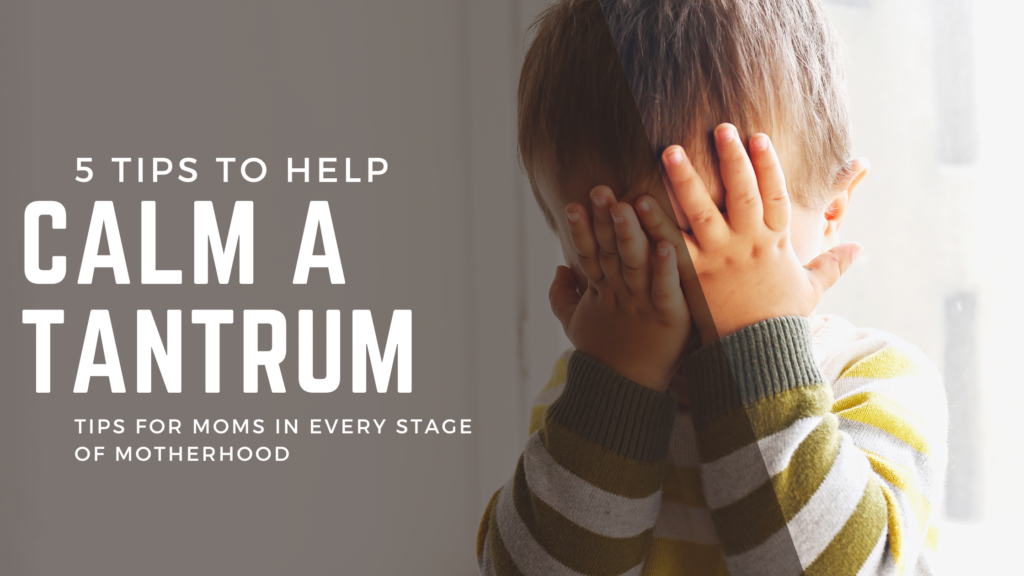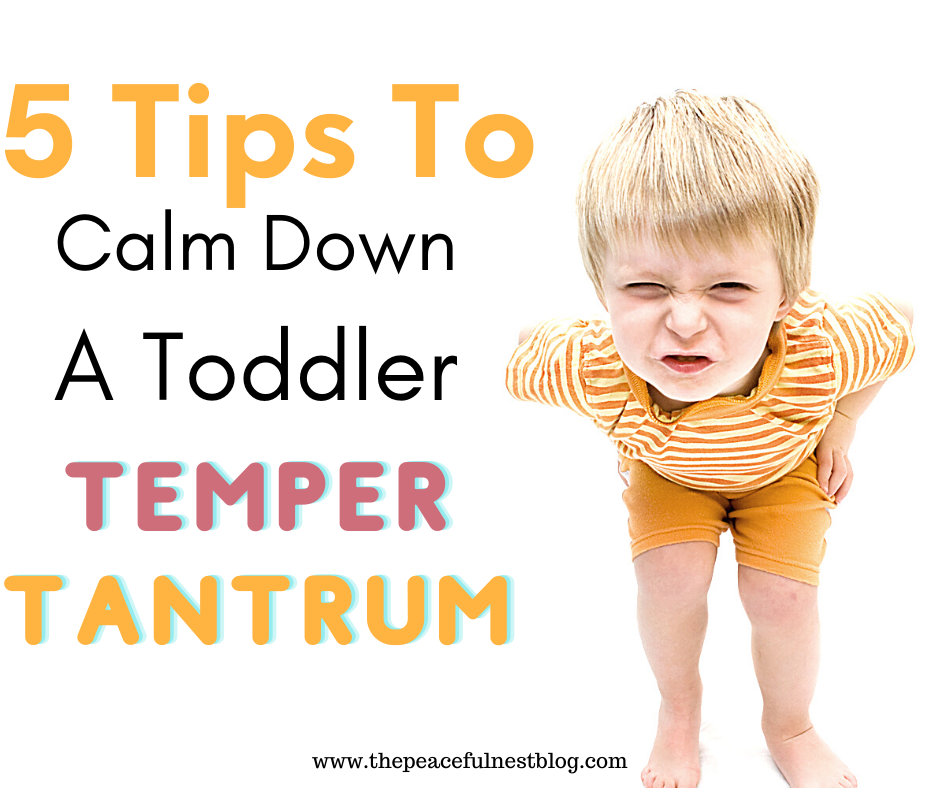Why do toddlers throw tantrums?

Have you ever been in a public place with your toddler, and suddenly, they are melting down? Maybe the tantrum came out of nowhere, or maybe you understand exactly why your toddler is having a tantrum. Everyone is staring at you, and you just don’t know how to help calm your child who is having a toddler tantrum.
The truth is toddlers have tantrums for several reasons.
One of the main reasons can be triggers. Toddlers will have specific triggers related to their temperament, personality, and need. As a parent we can be mindful of what our child’s triggers are so we can help avoid tantrums when we can.
Another reason for those tantrums can be because they don’t understand the emotions they are feeling. Adults sometimes have difficulty controlling and understanding their own emotions. So it’s not really reasonable to ask a child who doesn’t understand this big concept yet to control their emotions at all times. We can help them understand their emotions instead.
Is it more important to connect or correct?
What do I mean when I say connecting with your child is important? Sometimes I have been guilty of sending my child away when they are throwing a fit, maybe to a different room, or maybe I walk out, and I don’t connect with them because I’m just too irritated to deal.
A connection with your child’s heart is very important for your relationship with them and helps them mature and grow. Now is the connection to their heart more important than correction? I would say that both concepts go hand-in-hand and play an important role with each other.
Connection helps your child form a bond with you when they are having a difficult time. It lets them know that mommy or daddy will always be there when they are struggling.
Correction is guidance. It’s going to your child and helping them figure out the correct way to react to certain situations and how to treat other people.
Correction is extremely important when guiding your children, but it is not more important than connecting with your child. It is possible to do both simultaneously.

Can you connect with your toddler, pitching a fit while correcting them?
There is one piece of advice my mom told me when I became a mom and that her mom told her. It can be difficult to do sometimes, but it is important. When your child is having difficulty pitching a fit or having a temper tantrum, and you know that they will need a correction for their actions, it’s important to wait to correct her behavior.
Instead, it’s better to get on their level, help them calm down, and connect with them while they are having a tantrum than trying to correct their behavior.
Have you ever had somebody tell you to calm down while you’re in the middle of having a meltdown? It’s hard to even as adults. Telling your child to just calm down and then trying to correct their behavior or give them discipline during the temper tantrum can often lead to prolonged tantrums.
If it is absolutely necessary to give you a child discipline while they’re throwing a tantrum, but you don’t want to do time out, a great thing that you can do is called time in. ( of course, if you need to do time out, do what is necessary for your family.)
This is similar to a time out, except instead of placing your child somewhere away from you, you sit with them while they’re calming down during this time in.
5 Peaceful Ways to Help Calm a Toddler Tantrum
Say no to having your own tantrum.
It is tempting to give in to your temper tantrum while your child is having a tantrum. I know because I’ve done it before. It does not help your child, and it does not help you. All this really does is cause you to become more frustrated and irritated.
The first thing you can do when your child is having a temper tantrum that will help them is say no to having your own tantrum. Try your best to remain as calm as possible. If you have trouble remaining calm, pretend to be. Remember the saying, “fake it till you make it?” Or, if you have a partner who can help, try tag-teaming it.
Take charge of the tantrum when it’s necessary.
There will be moments when your child is throwing a temper tantrum, and it can be unsafe, or it’s important just to leave the place you are at.
Don’t be afraid to take charge at that moment.
Maybe your child has decided they would throw a fit in the middle of a parking lot. My child has done this before. Taking charge during those moments when your child is not safe is necessary. You can grab them gently and place them in the car or somewhere they can continue their temper tantrum or calm down.
Distract your toddler.
Distraction is a wonderful thing for a toddler. It may be more difficult to do this with an older child, but if your child is still a toddler, chances are you may be able to distract them while they are throwing a fit.
For example, maybe your toddler is upset that their sibling will not play with them, so they start throwing a temper tantrum. You could try distracting your child by suggesting a game you can play with her or putting on some music and getting their wiggles out. This works wonders for my children.
Give validation to your child’s feelings.
Children are human. Everybody needs to feel like their feelings and emotions are valid. It is no different for children.
When a child is told over and over to just stop, quit crying, you’re fine, etc., then they may start to believe the way they feel, their emotions, and their thoughts on a certain situation are not valid or important.
You can turn this around by validating your child’s feelings even if you do not understand them. Even if you believe how they’re feeling about something that seems silly, you can still talk to them and validate their feelings. This lets your child know that how they feel is important. Then their desire to throw a tantrum often may begin to diminish.

Get on their level and give them a hug.
This one is so simple. Human connection can help us calm down and regulate ourselves and our emotions. So getting down on your child’s level and giving them a hug, maybe counting to 20, can help them regulate their emotions.
If your child is not ready for human connection and they’re not ready for a hug, then you have to wait it out with them until they are ready.
The connection and bond with your child develop when they are melting down and having a difficult time.
How to Make a Tantrum Less Likely
Be consistent with your boundaries.
Boundaries are important as a parent. When raising your children, it is necessary to ensure they know what is acceptable and what is not. This may look different for every family. But what is important about boundaries is ensuring consistency with them.
I know that sometimes it’s difficult as a parent because we have so much on our plate and are tired. But if you don’t want your child acting a certain way and then the next day turn around and allow them to have this behavior, it sends mixed messages to your child.
For example, say your child has a problem with keeping their hands to themselves and not hitting other children. You tell your child it’s not OK to hit your sister, and maybe one day you will give a consequence for hitting their sister. But the next day, your child continues to hit, and you decide you’re too tired to deal with that behavior. This tells your child that it’s okay to hit my sister sometimes. I won’t always get in trouble. Your child will be more likely to try to get away with the action when they know the consequence will not be consistent.
Pay attention to your child’s triggers and needs.
Every person has needs and triggers. When your child is small, they may have more needs like naptime or eating more frequently.
As a mom, we can pay attention to when our child starts getting tired, when our child is hungry, etc. Paying attention to these triggers and needs can help you avoid unnecessary tantrums.
For example, if you know your child needs a nap at noon right after lunch, then it is not a good idea to plan an outing with your child where they will have to stay awake. Because expecting them to not be cranky during that time is not fair to them. Pay attention to your child’s triggers, and if you know your child is having a meltdown because they are hungry or sleepy or something like that, then it’s important to lower your expectations of them at that moment.

Talk to your child about emotions frequently.
Emotions are an abstract concept for our children to understand.
We can continuously talk to them about emotions while we feel certain ways, etc., which can help them become familiar with recognizing why they’re feeling the way they are.
It’s not gonna click overnight, especially when they’re young. But you can open the door and continuously talk to your child about emotions, “Hey, I see that you are feeling sad right now. You’re feeling sad because….” This helps your child become familiar with emotions having a cause and effect typically.
Plan ahead and be mindful of tantrum triggers.
Plan your day ahead of time, if you are a type-B personality like me, sometimes it can be hard to do this. But planning ahead helps you be mindful of any tantrum triggers that may happen.
If you have to go to the grocery store with your toddler, maybe it’s a good idea not to go in the middle of the day when your child will be tired. Or leaving them with a babysitter can help you avoid a tantrum that can be avoided.
Related: 14 Best Tips To Overcome Angry Mommy Today
Toddler tantrums aren’t unavoidable but can be a great way to connect with your child.
Don’t become discouraged when your toddler is having a tantrum. The truth is this time is very fleeting; eventually, they will mature and grow out of these temper tantrums!
If you are new to the Peaceful Nest Blog, welcome!
Be sure to read my top posts on parenting:
- Why Consistent Parenting Matters
- 12 Habits of Immensely Peaceful Moms
- 63 Mom Hacks That Are Pure Genius
- Connect With Your Child and Build Up Their Heart
Are you looking for ways to become a peaceful mom but you aren’t sure how?
I created a free planner for moms like me, who want to create a peaceful home but let the stress of never having it all together defeat them, because whoever has it together? The best we can do is plan for peace and roll with the punches, right? If you want your free planner you can get it below!
Are you looking for a mommy tribe?
Our Facebook group, From Chaos to Calm, is full of encouraging and supportive moms just like you. We would love to have you join us! Join From Chaos to Calm Mom group on Facebook.
Don’t forget to follow The Peaceful Nest on Facebook and Instagram!
And remember, sharing is caring! Share this post on Pinterest below!

Hi there, I’m Jenna! I am a devoted mommy and wife. As well as an advocate for children and creating a peaceful atmosphere for those we love. I co-wrote Faith Actually: Living Life After Tragedy with my husband. I have my Bachelor’s Degree in Biblical Studies and currently working toward my Master’s in Positive Psychology. My number one desire is to create a peaceful home life for my family. My second desire is to share with you the tips I learn along the way!



Help Your Toddler De-Escalate From A Tantrum - The Peaceful Nest
Thursday 4th of March 2021
[…] to help your child de-escalate quickly. Here are some more ideas on helping your child learn to self-soothe and calm down during a […]